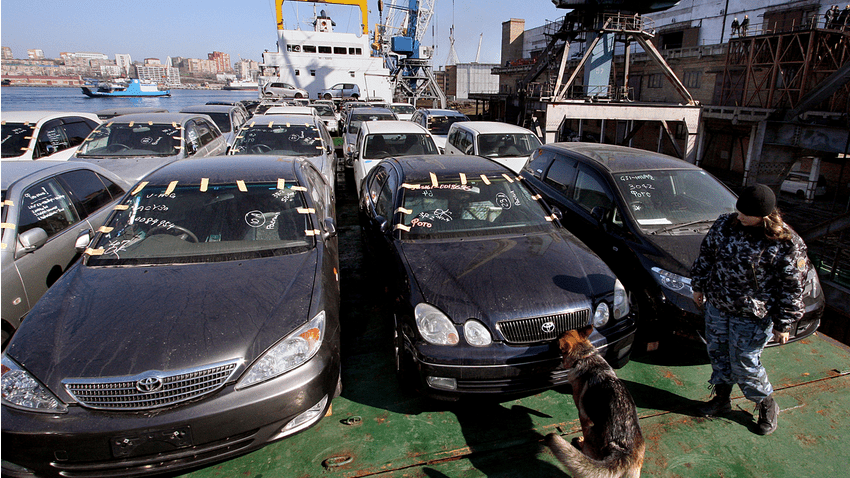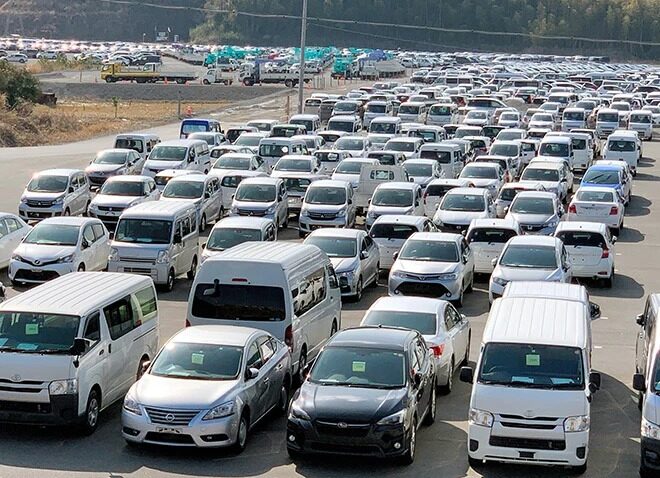Despite imposing various sanctions against Russia, Japan is still exporting a huge number of used cars to the country. Export figures show that the number of used cars exported to Russia have tripled since May 2022 and about 40,000 more cars are waiting to be sent over to Russia.
The Asahi Shimbun reports that in late June, the Vladivostok Port in Russia’s Far East was packed with new and used cars transported from Japan and South Korea. Many of them are SUVs, minivans and large luxury models. According to the report, Russian companies said they were flooded with orders from across the country and were often forced to stop taking orders as they were unable to meet the demand.
Related: Soaring Used-Car Prices in Japan
Viktor Lutsyk, 32, head of the cargo department of a facility management company at the port said there was a shortage of parking spaces there after a sharp increase in cars imported from Japan and other countries. A logistics company official said it used two cargo ships to transport 2,000 used cars from Japan each month. The company was unable to increase its transport capacity due to limited freight services and the port was also packed with cargo.

Used car importer Carwin Plc CEO Dmitriy Zabora said the Vladivostok based company had to temporarily stop accepting orders because prospects remained uncertain due to the situation in Ukraine. However Carwin was swamped with orders shortly after it resumed imports in April. He said they received about 300 orders in June, a more than threefold increase compared to before the conflict started.
Related: Russia Lowers Vehicle Safety Standards After Sanctions
According to Zabora, around 18,000 used cars are transported to Russia from Japan per month. However, the sharp increase in orders is causing delays as arrangements need to be made for cargo ships and storage facilities, as well as customs procedures.

The Asahi Shimbun report said between 40,000 and 45,000 vehicles have been purchased and were waiting for loading in Japan. Further compounding the issue is that Japanese shipping companies have stopped their services from Yokohama and Kobe to Russia’s Far East due to the economic sanctions against the country.
Related: Why JDM Cars Are Considered a Threat to Local Assembled Ones
The report also said that Japanese used cars have become cheaper mainly due to the strong Russian ruble. Before the conflict started, 1 Ruble was around 1.5 Yen and it dropped to less than 0.9 Yen shortly after that. But the Ruble has rebounded since late April, hovering around 2.5 against the Japanese Yen at one time. The Ruble is currently hovering around 2.3 against the Yen.

Based on these numbers, a used car worth 3 million Yen in Japan was worth about 2 million Rubles before the conflict and it has now dropped to about 1.2 million Rubles. The falling prices of imported cars are also contributing to the dwindling sales of new cars in Russia.
Related: Free Market and the import of CBUs
Japan’s economic sanctions against Russia include an export ban on luxury cars worth more than 6 million Yen, medium and large trucks and other vehicles. However, money transfers are not affected at the moment. According to Hiroshi Sato, chair of the Japan Used Motor Vehicle Exporters Association:
“The sanctions have little effect. The tendency will likely remain unchanged as long as the ruble continues to appreciate.”
Since the start of the conflict on 24th February 2022, many foreign automakers exited Russia and stopped trade with the country due to the severe economic sanctions. This isolated Russia and the Ruble temporarily nosedived, but it did not affect much of Russia’s exports of oil, natural gas and other resources as they were in high demand.

The Asahi Shimbun said these triggered sharp declines in purchases of US Dollars and Euros to pay for imported goods. As a result, the amount of rubles to be bought by selling foreign currencies obtained through exports became much bigger. This situation allowed the Ruble’s exchange rate to rise.
Related: Japan Battery Material Producers Lose Spark as China Races Ahead
The report said global vehicle production continues to be unstable because of the worldwide semiconductor shortage and other factors. This has resulted in a growing demand for used cars. It is also possible that exports to Russia will peak due to the used car supply shortage in Japan and elsewhere.
Source: NST

A computer animation professional with over 23 years of industry experience having served in leading organizations, TV channels & production facilities in Pakistan. An avid car enthusiast and petrolhead with an affection to deliver quality content to help shape opinions. Formerly written for PakWheels as well as major publications including Dawn. Founder of CarSpiritPK.com




